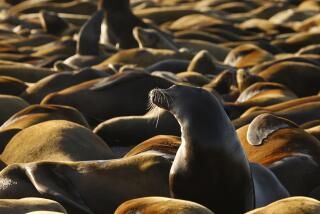Pelican Colony Thriving in Chesapeake Bay
- Share via
NEAR BLOODSWORTH ISLAND, Md. — Seven young pelicans, squawking angrily at the human intruders who have invaded their desolate island, try an end run around Dave Brinker.
Squatting near a chest-high salt marsh elderberry, he grabs the biggest bird and thrusts it between his legs. “Grab the ringleader and you’ve got everything covered,” says Brinker, an ecologist with the Department of Natural Resources.
Sure enough, the six remaining pelicans mill about in noisy protest, making no real effort to escape, as Brinker and two helpers attach a metal band to one leg of each bird.
As recently as the 1970s, pelicans were on the federal endangered species list, as their numbers plummeted because of the negative effects of the pesticide DDT. Small concentrations of the pesticide that were ingested as pelicans fed on fish caused them to lay eggs with thin shells or none at all.
But with the banning of DDT, they made a remarkable comeback, filling nesting grounds in the southeastern United States.
This is Brinker’s third and final visit this year to the northernmost colony of brown pelicans on the Atlantic Coast. Their home is a small narrow island, maybe a quarter of a mile long, off the southern tip of Dorchester County near Bloodsworth Island. Brinker keeps the name of the island secret to protect the birds from their only potential predators, human beings.
Brinker, Roger Stone of the U.S. Fish and Wildlife Service and Chris Crow, an intern with the federal agency, spend about an hour on a muggy August morning banding young pelicans who have not yet learned to fly. Each band bears a telephone number and a request that anyone finding a banded bird call and provide the identification number pressed into the lightweight band.
Birds banded by Brinker have been found as far north as New Jersey and as far south as Cuba.
“The purpose of the banding is to find out how long pelicans live, where they disperse to when they leave the island,” Brinker said. “It helps us make decisions about what kinds of habitat we protect.”
On this visit, Brinker bands 45 young birds to go with 185 banded on the two previous trips. They are the stragglers in this year’s class; most other pelicans hatched this year already can fly and have left their nests.
The only other colony in Maryland is at Smith Island just north of the boundary with Virginia, where pelicans began to nest in 1987, 11 years before they were first found on the second island a little farther north. The Smith Island colony is much larger, and Brinker has banded 1,480 young birds there this year.
As the boat bearing Brinker and his helpers nears the mystery island, flocks of birds take to the air, circling overhead while keeping a wary eye on the intruders.
The birds are a mixture of pelicans, double-crested cormorants and three species of gulls. The pelicans, Brinker explains, are the brownish birds that look like small pterodactyls. Their wings, which can extend to six feet when fully grown, fold back on their bodies, allowing them to plunge into the water to catch fish.
On the island, just a few tan eggs remain in rough nests of sticks and twigs--about the size of large Thanksgiving turkey platters--built just off the ground on logs and in low elderberry bushes, the largest vegetation on the island.
At one of the first nests encountered by Stone, a small purplish baby pelican is pecking its way out of its shell. The baby bird probably won’t make it, Brinker said. It is so late in the season that the bird likely will not mature in time to make the journey south when other birds leave for winter grounds located from North Carolina south to Florida.
A few “naked birds,” gray featherless babies that are blind and helpless, sit in their nests, making little squawking noises and thrusting their open mouths skyward, waiting for a parent to feed them small pieces of fish. They are too small to be banded, and it may be too late for them too.
The first pelicans began to leave at the end of August. Most are gone by the end of October, although a few may stay around until December if the early winter is mild and fish are available to feed on.
With the end of summer, most of the juveniles are almost ready to take to the air. They are now covered with white and brown feathers and already are larger than the plumpest chickens grown in Eastern Shore poultry houses.
Eggs take about five weeks to hatch, and young pelicans learn to fly within eight weeks of hatching.
After about an hour, with all the young pelicans banded, Brinker’s party leaves the island, giving the adults a chance to return and check on their young.
Brinker said there is no historical record of pelicans ever existing in large numbers in Maryland. The first sightings were “in the early 1930s, one here, one there,” he said.
That changed with the establishment of the colony on Smith Island.
“Pelicans are here to stay unless something dramatic happens,” Brinker said. And, unless climate changes produce considerably colder winters, he expects them to move even farther north.
“I can’t imagine it just stopping here. What’s happening here makes it almost a certainty they will be in New Jersey within 10 years,” Brinker said.
*
U.S. Geological Survey: https://www.pwrc.usgs.gov/bioeco/bpelican.htm
More to Read
Sign up for Essential California
The most important California stories and recommendations in your inbox every morning.
You may occasionally receive promotional content from the Los Angeles Times.













